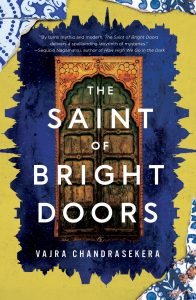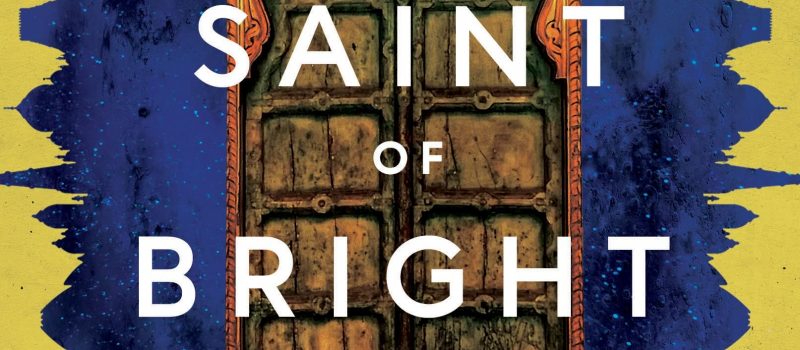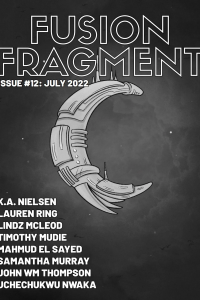Jake Casella Brookins Reviews The Saint of Bright Doors by Vajra Chandrasekera
 The Saint of Bright Doors, Vajra Chandrasekera (Tordotcom 978-1-250-84738-6, 368pp, hc) July 2023.
The Saint of Bright Doors, Vajra Chandrasekera (Tordotcom 978-1-250-84738-6, 368pp, hc) July 2023.
Books that are good to mediocre, but entertaining or idea-filled, are easy to talk about. Books that are troubling or problematic are easy to talk about. Even badly written books, if they’re entertaining or problematic, are easy to talk about. Truly superb books – ones that are complete, that are organic, that invite themselves into your brain fully formed and transport you somewhere else, that leave you humming and staring and obsessed, that leave characters and images and ideas hard-printed among your own memories – are hard to talk about. It’s hard to talk about Vajra Chandrasekera’s The Saint of Bright Doors.
Well, let’s begin with the simple bits. A secondary-world fantasy, the novel follows Fetter, a boy with strange gifts – shadowless, able to see demons, able to slip off gravity like a loose robe. Born to a (not the) messiah, Fetter is trained by his mother – herself something of a potent magician – to kill his own father, and take apart his entire religion. But at some point in his youth Fetter walks away from his patricidal mission, moves to the city, begins a new life. Joins a support group for other former Chosen Ones. There, in Luriat, the city of the titular bright doors, Fetter begins to discover who he really is, who he really wants to be – and finds himself caught up in a complicated mesh of revolution, scientific inquiry, and the strange and ground-shaking truth of his world.
I’ll admit that I’m something of a sucker for the old chestnut: “what genre is this?” And am thus all the more tickled when a work really ducks that question. The Saint of Bright Doors starts in a clearly mythic, fantastic mode; twenty pages in Fetter is using dating apps, discussing crowdfunding campaigns. The supernatural elements persist, become deeper and stranger, even as Fetter’s world is revealed to be about the same as our contemporary world, technologically; yet Chandrasekera doesn’t juxtapose these elements winkingly or for laughs. The world hangs together, and for all that the story’s magical elements feel real, have the unpredictable-but-inevitable feeling of a dream or a fairy tale, it’s not an unquestioning world: Fetter, and other characters he meets, engage with the world, even the magical bits, study them, question them, draw conclusions from them. Chandrasekera is able to call his own bluff, repeatedly, in ways that feel very science-fictional – and still reveal that there are more and stranger cards to be dealt.
With a book this striking, it’s easy, trying to describe it, to fall down a rabbit hole of comparisons. And yes, throughout this novel I was thinking of Sofia Samatar’s Olondrian novels and short work (the sheer beauty, assuredness, and potency of the writing, the incredible solidity and sensuousness of the world), Michael Swanwick’s The Iron Dragon’s Daughter (the playful and serious mixing of magic and technology, the awareness of story itself as both magic and technology), and China Miéville’s Iron Council (the darkly exuberant creativity, the politics both deadly real and actually inspiring). There’s a tenderness and a formal tricksiness here that put me in mind of Simon Jimenez or Nick Harkaway, and a surreal and sometimes gorily inventive logic that recalls Yoon Ha Lee. But of course, these comparisons only point you vaguely in the direction of what The Saint of Bright Doors reads like, because, like these others, it has a remarkably unique and coherent texture.
Alongside these absorbing, convincing details – city streets and noises, food, clothing, architecture, characters who entail a whole set of cultural assumptions in their table manners, unforgettably strange devils and apparitions – one of the more striking aspects of The Saint of Bright Doors is its commitment to the revolutionary impulse and societal critique. Fetter’s mother told him, “The only way to change the world is through intentional, directed violence.” It’s a statement he’s ambivalent about at best, particularly about how directed such violence can ever be, but he finds himself drawn into the orbit of reformists and revolutionaries, appalled at the intrinsic atrocities of the state. This is not a black-and-white moral story: The Saint of Bright Doors captures the Byzantine complexity and reifying systemicity of state violence – and Chandrasekera’s subversion of Chosen One narratives is delightfully oblique, allowing Fetter his confusion and side quests, and pivoting the narrative away with a few absolutely stunning twists.
Beyond these politics (if there is such a thing), the novel deploys some truly huge ideas in how it plays with the writing and rewriting of history and culture, how events and interpretations layer and contradict each other, are locked away for lifetimes only to emerge again. It’s a heady literalization of “mashing up;” it takes a serious look at what happens when tropes and cultures collide, and it’s all the more satisfying for how grounded in character it all is. Fetter is a wonderfully drawn and complex young man, surrounded by equally complex characters and realities that he (and thus we) understand imperfectly. A lot of my favorite moments in the book stem from Chandrasekera’s remarkable sense for stakes of personal, rather than contrived, significance – Fetter’s guilt over merely feeling attracted to someone, and the way his boyfriend laughs it off; the way that personal possibilities, that others’ opinions, are on the table as potential sacrifices or rewards – far more compelling than stock melodramatic life-or-death, save-the-universe plot points.
It’s a hard book to talk about – I’ve gone this far and barely told you about the present-on-every-page fantastic elements, the mechanics of the bright doors, the importance of theater, the dances of the devil-doctors and the demonic surveillance-state-analog of Fetter’s father and his saints. There is so much going on here, and yet it all fits together perfectly – book of the year material, no question, and one I’m already returning to.
Jake Casella Brookins is from the Pennsylvania Appalachians, and spent a fantastic amount of time in the woods. He studied biology, before switching over to philosophy & literature, at Mansfield University. He’s been a specialty coffee professional since 2006. He’s worn a lot of coffee hats. He worked in Upstate New York and Ontario for about 8 years. He’s been in Chicago since 2013; prior to the pandemic, he worked for Intelligentsia Coffee in the Loop. Starting in 2021, he’s been selling books at a local indie bookstore. He lives with his wife, Alison, and their dogs Tiptree & Jo, in Logan Square.
This review and more like it in the September 2023 issue of Locus.
 While you are here, please take a moment to support Locus with a one-time or recurring donation. We rely on reader donations to keep the magazine and site going, and would like to keep the site paywall free, but WE NEED YOUR FINANCIAL SUPPORT to continue quality coverage of the science fiction and fantasy field.
While you are here, please take a moment to support Locus with a one-time or recurring donation. We rely on reader donations to keep the magazine and site going, and would like to keep the site paywall free, but WE NEED YOUR FINANCIAL SUPPORT to continue quality coverage of the science fiction and fantasy field.
©Locus Magazine. Copyrighted material may not be republished without permission of LSFF.






